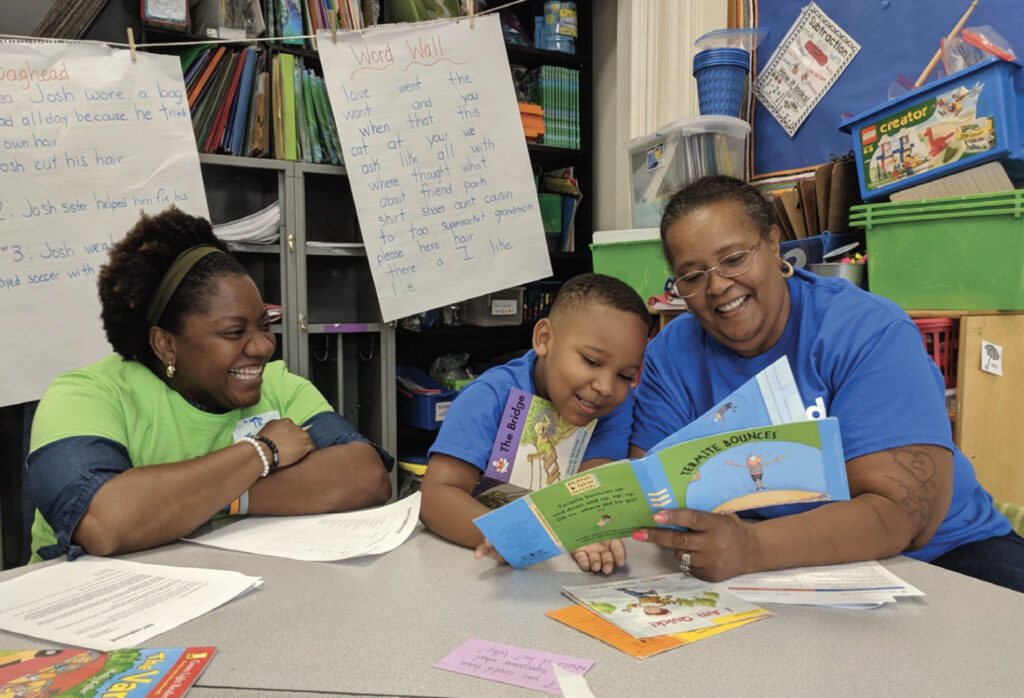Working with children and parents for literacy gains
Research has shown that students in under-resourced communities lack continuous access to learning at home and school, resulting in slow progress during the school year and literacy slides over the summer. School closures during COVID-19 have made inequities starker, as children in poorer school districts learned at home with less digital access and fewer resources. McKinsey estimates that distance learning will exacerbate existing academic gaps for low-income, Black, and Hispanic/Latinx students by 15% to 20%. Springboard Collaborative works to prevent this pandemic from deepening inequality for an entire generation of children by equipping families to support learning at home.
What It Does
Since 2011 Springboard Collaborative, a nonprofit based in Philadelphia with programs in multiple cities, has helped close the literacy gap by bridging the gap between home and school. Springboard’s model takes a hands-on approach to involving parents—not just teachers and students—in literacy learning. Their approach combines home visits, instruction, family workshops, coaching, and learning bonuses.
Springboard Collaborative uses a method called Family-Educator Learning Accelerators (or FELAs). FELAs are five- to 10-week cycles during which teachers and parents team up to help children reach learning goals. During a FELA, teachers typically work with 10 to 15 students in need of academic support, along with their parents. The experience kicks off with a home visit (in person or virtual) to build relational trust. The next steps include setting a baseline and achievable goals, then practice daily with parents and weekly (or more often) with teachers. The program concludes with growth assessment and progress celebration.
Within days of COVID-19 school closures, Springboard launched a free resource portal with a parent page featuring a four-week learn-at-home plan with weekly strategies (by video), daily lessons, and e-books. The teacher page features a four-week family engagement plan as well as virtual professional development sessions. Springboard gave families free access to Springboard Connect (an app with personalized support) and virtual workshops hosted on Facebook Live. They established distribution partnerships with large networks including teachers’ unions, the national PTA, TFA, National Parents Union, Univision, Common Sense Media, and Learning Heroes.
In April, Springboard launched Springboard Learning Accelerators (SLA), a starter kit for implementing FELAs remotely or in-person, at any time during the year, not just summer. These programs can be embedded into the school day or implemented as an out-of-school-time program. The response from school/district leaders was immediate. Springboard Collaborative is now serving more than three times as many children—and 10 times as many schools—as they reached in person. A home literacy app, family resource portal, and distance learning make it possible to reach rural communities where it had previously not been financially or operationally feasible to run programming.
How Effective It Is
During in-person programs, students average a 3-4-month reading gain during each five- or 10-week program cycle, closing the gap to grade-level performance by more than half. A recent external evaluation found that the largest gains were for students who started below grade level. Rising fourth graders who started programming more than a year below grade-level averaged a 4.4-month gain. A Harvard researcher leading a comparative, multi-year study in Oakland found that Springboard is the district’s most effective—and cost-effective—investment in literacy.
Within the hybrid and remote environments required by COVID-19, parental involvement in learning is essential. Through Springboard Learning Accelerators, parents learn how to be effective home literacy coaches. For every hour that a teacher leads a family workshop, parents deliver 25 hours of home-based instructional time. Attendance at Springboard’s virtual family workshops is averaging 90%+, despite the challenges of the digital divide. Across Washington, DC public schools, virtual workshops averaged 99% parent attendance, with families reading an average of 101 books per student in just five weeks. Follow-up studies demonstrate that parents— and teachers—sustain habits long after each program cycle has ended.
Additionally, Springboard Collaborative has had 15,209 sign-ups for their home literacy app since March 2020. Their family resource portal has been visited over 11,600 times, and online videos for families have been viewed over 34,000 times since March.
How You Can Help
To donate any amount, visit Springboard Collaborative’s website. A $15 donation pays for one take-home book pack, while $100 pays for one backpack and home library. $900 pays for home libraries for one Springboard class, and $4,350 establishes a full independent reading library for a whole Springboard school.
More Ways to Help — To learn more about investing in early childhood education, visit CHIP’s Early Childhood Toolkit. Find more two-generation approaches to support young children in Two-Generation Lens: Helping Children by Helping Families.

